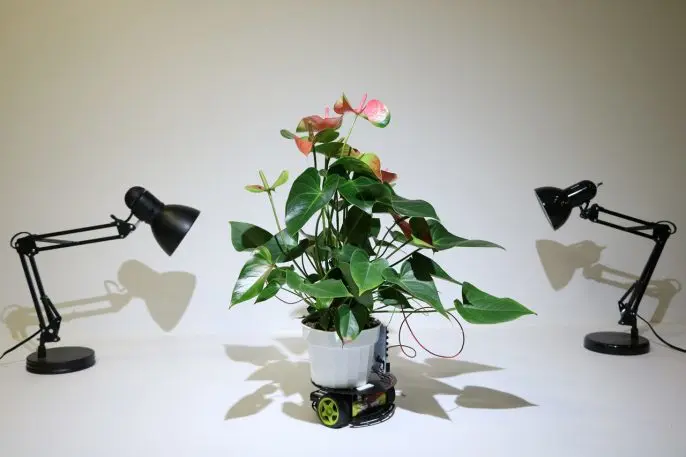“Green technology” might conjure up images of wind farms or solar cells. But one researcher at Parsons takes the phrase a bit more literally.
Harpreet Sareen, an assistant professor at the Parsons School of Design and an affiliate researcher at the MIT Media Lab, has created a robotic plant that acts like a light sensor. The plant’s leaves are hooked up to wires, which can sense the small electrical signals within the leaves that respond to the presence of light. When the plant detects that there’s light nearby, these signals trigger the wheels of its robotic planter, which autonomously moves toward the light source.

“Usually, we create artificial electronics to do such functions for us, but plants inherently have such capabilities,” Sareen tells Fast Company via email. “They can sense and they can display–they are already an interface.”
But unlike a screen, which is artificially manufactured, Sareen points out that plants are self-powered, regenerating organisms that grow on their own, which gives their potential as interfaces an entirely new dimension.
“If nature has those capabilities, such as of sensing (signals inside plants), response (plant movement, color change, leaves opening/closing, growth etc.), then why not tap into those capabilities of what nature does best?” he says. “This I believe can be the future of interaction–where we don’t think of interfaces as separate but within nature itself.”
For instance, instead of using a light sensor in your office to ensure that employees are getting enough natural light, a plant hooked up to a computer could do just as good of a job. Similarly, plants could act like humidity or even air quality gauges. (And they’ll look a lot nicer on your desk than any gadget, too.)
Sareen is studying the signals inside plants to understand how to activate and manipulate them to create new interfaces, which he calls “Cyborg Botany.” He’s planning to build more prototypes showing how plants can act as monitoring devices, tracking things like temperature, light, their own health, or other tiny changes in the environment. A Cyborg Garden, full of robotically enhanced plants, is in the works.
Recognize your brand’s excellence by applying to this year’s Brands That Matter Awards before the final deadline, June 7.
Sign up for Brands That Matter notifications here.